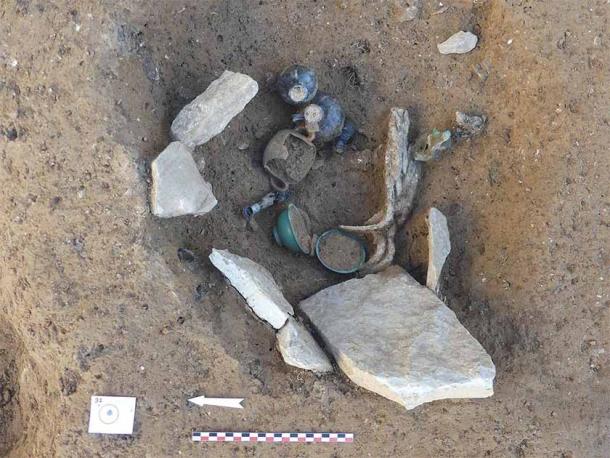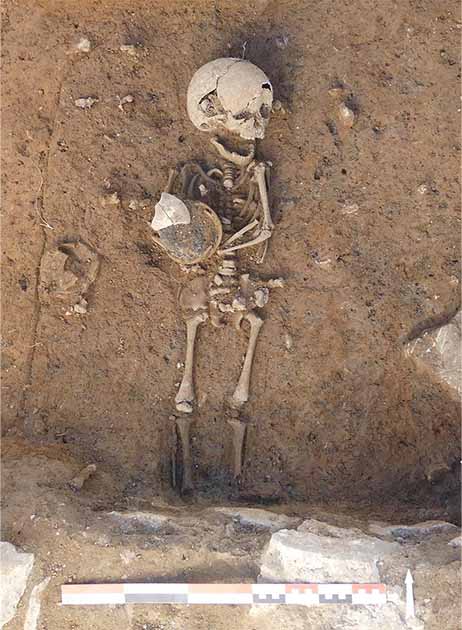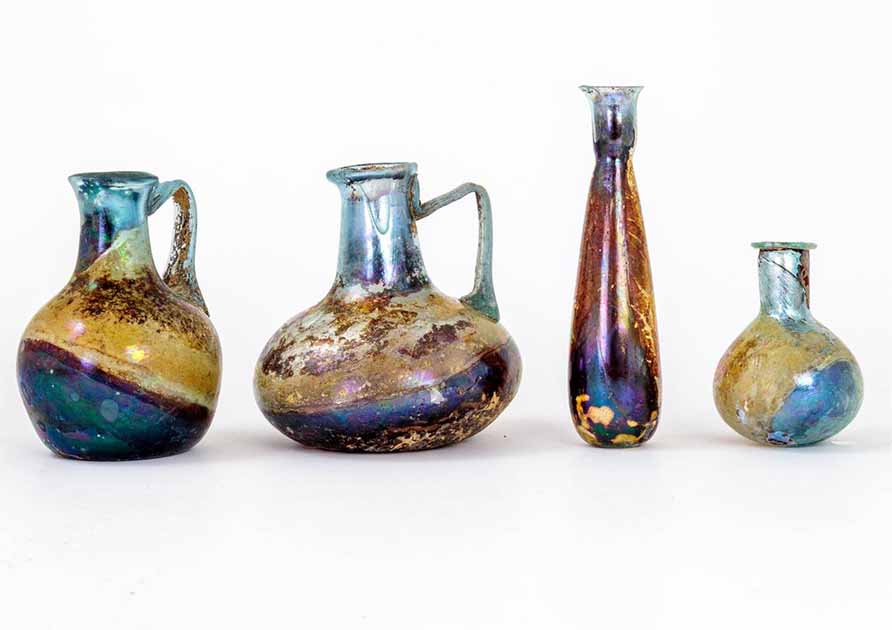Discoveries Made in Roman Nîmes Include Stunning Glassware
During the development of a social housing residence in Rue de Beaucaire in Nîmes, archaeologists have uncovered a series of ancient structures including tombs and funeral pyres. These Roman finds date back to between the 2nd and 1st centuries BC and the 2nd century AD.
Several of these pyres were constructed from limestone rubble or stacks of terracotta tiles, while others were simply dug into the ground. The discoveries were made along the border of the Via Domitia, a major roman road.
Roman Roads and Elite Graves
The Via Domitia, the first Roman road built in Gaul, was a major route to Nîmes. The excavation revealed elements along this route, including a large trench which was replaced over time by a wall.
- Impressive Roman Glass Shipwreck Found Near Corsica
- Built to Last: The Secret that Enabled Roman Roads to Withstand the Passage of Time

The Nîmes finds in situ in a secondary cremation deposit (Archaeology News / V Bel / INRAP)
A second main route, 15 meters (50 feet) wide, was also discovered during the excavation. Running northeast to southwest and following a different orientation from the Via Domitia, it was composed of successive stone pavements, reports a press release by French National Institute for Preventive Archaeological Research (INRAP).
The passage of intense traffic has worn down the stones over centuries of use, evident from the grooves and occasional refills. While its status remains uncertain, its origins trace back to the late era of the Roman Republic, similar to the Via Domitia.
A total of 15 burials along the route have been identified, with the majority being post-cremation burials alongside several inhumation burials. Numerous high-status grave goods were found together with the deceased, including strigils (tools for body cleansing before bathing), ornate glass vases, ceramics, a glass paste cup, lamps, and fragments of funerary monuments and amphorae.
Burnt bones from the cremations were collected and deposited in tombs, often with personal belongings of the deceased. Cremation was a common practice in the Roman Republic and early Roman Empire, and the bodies of the first Roman Emperors and their families were themselves burned.
- 1800-year-old Shard of Roman Glass Left A Fishy Trail From the Black Sea
- Archaeologists Unearth Two Luxury Roman Townhouses In Nîmes, France

Burial of a child with a ceramic vessel (Archaeology News / J Grimaud / INRAP)
The relatively intact glass vases were deposited during feasting rituals known as the “refrigerium”, a commemorative meal held on the day of burial. Conducted by priestesses, the refrigerium centered on the consumption of wine in glass vessels, reports The Heritage Daily.
An ancient well, with its curb removed, was also discovered, providing an opportunity for further excavation and collection of remains from surrounding tombs and monuments.
Blue and Gold Glassware
Of particular interest is the largely intact glassware which has been recovered from the excavation. It is very rare to find such beautiful and well preserved glassware, but what really dazzles are the deep blue and gold tones of the glass itself, which make the items shimmer with impossible beauty.
These stunning colors are due to several factors. The first are the impurities in Roman glassware, most typically iron which causes a greenish tint common in the era.
However these items also grew more beautiful over time thanks to the photonic nanostructures in the glass itself. These layers were abraded over the course of centuries and as they did so they slowly changed to produce new colors, not as a result of pigmentation but instead in how they refract light, similar to the wings of a butterfly.
Roman Roads in France
Roman road building practices in France were characterized by a systematic approach aimed at constructing durable and efficient transportation networks. These roads served as vital arteries for military, economic, and social communication throughout the Roman Empire.
The construction of Roman roads typically began with careful planning and surveying to determine the optimal route, and facilitate faster travel, generally constructed in straight lines.
The foundation of Roman roads consisted of multiple layers of materials, starting with a compacted layer of gravel or sand to provide a stable base. On top of this, large stones or blocks, known as the statumen, were laid to further strengthen the road's foundation.
The next layer, called the rudus, consisted of smaller stones or gravel mixed with lime mortar, which was compacted and leveled to create a smooth surface. This was followed by the nucleus, composed of concrete or smaller stones mixed with mortar, which formed the main body of the road. Finally, the surface layer, known as the summum dorsum, was added.
Top image: Some of the stunning Roman glassware recovered from the Nîmes site. Source: INRAP / C Coueret / Heritage Daily.
By Sahir Pandey
References
Carvajal, G. 2024. A Previously Unknown Roman Road, Lined with Funeral Pyres, Found in Nîmes. Available at: https://www.labrujulaverde.com/en/2024/04/a-previously-unknown-roman-road-lined-with-funeral-pyres-found-in-nimes/
Milligan, M. 2024. Archaeologists uncover exquisite Roman glassware in Nîmes. Available at: https://www.heritagedaily.com/2024/04/archaeologists-uncover-exquisite-roman-glassware-in-nimes/151466
Radley, D. 2024. Archaeologists uncover burials with fine glass goods along Roman road in France. Available at: https://archaeologymag.com/2024/04/burials-with-fine-glass-goods-along-roman-road-in-nimes/
Durrani, J, 2023. Ancient Roman glass fragment changed from green to gold over time. Available at: https://www.chemistryworld.com/news/ancient-roman-glass-fragment-changed-from-green-to-gold-over-time/4018127.article

















